17.07.2025
The Axiom-04 mission has successfully concluded with the return of ISRO Gaganyatri Shubhanshu Shukla, marking a proud moment both for ISRO and India as he returned after a historic 18-day scientific mission aboard the International Space Station (ISS). Launched on June 25, 2025, aboard the SpaceX Dragon spacecraft, the mission was conducted in collaboration with NASA, Axiom Space, ESA, and other international partners.
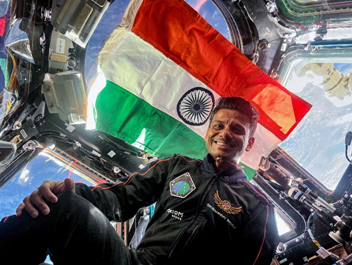
National Flag flying high onboard ISS
During his stay aboard the ISS, Shubhanshu Shukla adapted exceptionally well to the microgravity environment. Despite the physical and psychological challenges of spaceflight, he maintained optimal health throughout the mission. He captured a wide array of photographs and videos documenting life and work in orbit.
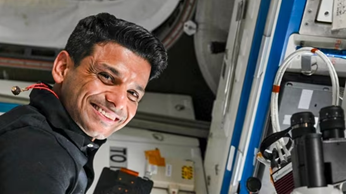
Shubhanshu Shukla onboard ISS
ISRO-Led Scientific Experiments Completed
Gaganyatri Shubhanshu Shukla completed a suite of seven microgravity experiments developed by Indian research institutions under the Human Space Flight Centre’s (HSFC) coordination. These experiments explored muscle regeneration, algal growth, crop viability, microbial survivability, cognitive performance in space, and the behaviour of cyanobacteria—each aimed at enhancing understanding of human spaceflight and microgravity science. The experiments are listed below
- Space Microalgae (ICGEB &BRIC-NIPGR, New Delhi): Growth and radiation response of edible algae
- Myogenesis (BRIC-InStem, Bengaluru): Muscle regeneration with supplement treatment
- Sprouts (UAS & IIT Dharwad): Microgravity growth of methi and moong
- Tardigrade (IISc, Bengaluru): Resilience and ageing patterns of tardigrades
- Electronic Displays (IISc, Bengaluru): Cognitive testing with in-flight user interface displays
- Cyanobacteria in Microgravity (ICGEB, New Delhi): Comparative growth and proteomics
- Food Crop Seeds (IIST & KAU, Thiruvananthapuram): Impact of microgravity on seed physiology
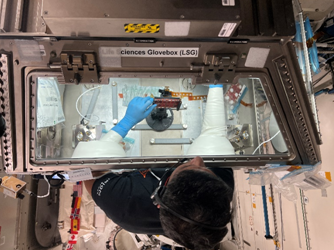
Shubhanshu Shukla doing science experiment
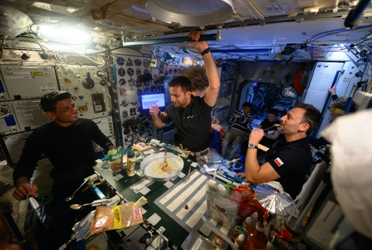
Meal time on ISS
All experiments were completed successfully, and samples have been returned for detailed post-flight analysis.
Shubhanshu Shukla worked in close partnership with members of Axiom-04 Crew and Expedition 73, contributing to the daily rhythm of ISS operations and supporting joint science, maintenance, and outreach efforts. He participated in integrated crew timelines, shared resources aboard the Harmony module, and coordinated multiple crossover activities, fostering international cooperation in space.
Public Engagements
Axiom-04’s public outreach component was an integral part of the mission, connecting India’s space achievements with its citizens and students. These events underscored the importance of inspiring the next generation while celebrating national pride.
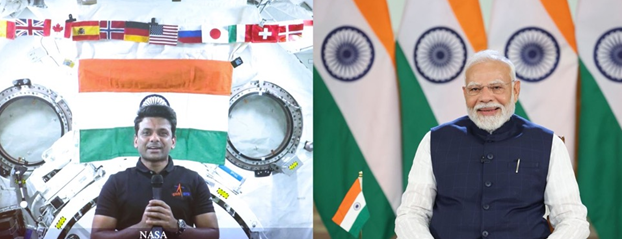
Interaction with Hon. Prime Minister
On June 28, 2025, Gaganyatri Shubhanshu Shukla participated in a historic live interaction with Hon. Prime Minister Narendra Modi from aboard the International Space Station. During the conversation, the Hon. Prime Minister commended Shukla’s contribution to India’s space journey and spoke of the pride the nation feltin seeing its flag represented in orbit. The broadcast reached millions across India and marked a symbolic milestone in India’s space diplomacy.On July 03, 2025, Gaganyatri Shubhanshu Shukla interacted with school students from Trivandrum and Lucknow through a video link, where he answered many questions on how to become an astronaut and life onboard the International Space Station.

Student event at Trivandrum
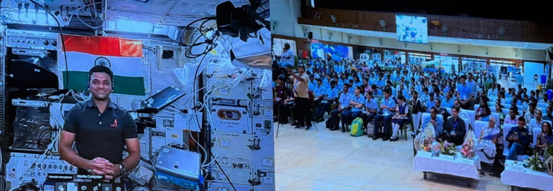
Student event at Lucknow
This was followed by two Amateur Radio on the International Space Station (ARISS) sessions that enabled real-time conversations with school students. The first session was held on July 4, 2025, with students and engineers at URSC, Bengaluru, where Shukla fielded questions on life in space, daily routines aboard the ISS, and the significance of scientific research in microgravity. The second session, conducted on July 8, 2025, connected students from seven schools in Northeast India through a coordinated link with NESAC, Meghalaya, providing them with a rare opportunity to speak directly with an Indian astronaut in orbit.
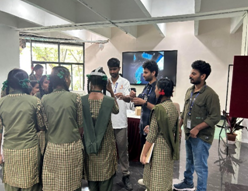
HAM radio session - URSC
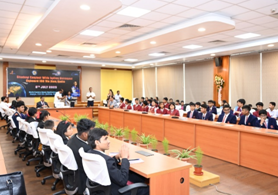
HAM radio session - Shillong
On July 6, 2025, Shukla also held a teleconference with the Chairman of ISRO, updating him on the progress of the Indian science payloads and sharing preliminary observations. The exchange reinforced the strong operational link between ground teams and the astronaut, ensuring real-time alignment of mission objectives.
These engagements not only enhanced visibility of the mission but also served to bridge the gap between India’s space program and its young aspirants, creating lasting inspiration across generations.
Final Mission Phase Events
The formal Farewell Ceremony for the Ax-04 crew was conducted aboard the ISS on July 13, 2025, at approximately 19:25 hrs. IST. Expedition 73 crew members and mission control teams expressed appreciation for the collaborative efforts and marked the occasion with symbolic gestures of international friendship, including commemorative mission patches and final photographs in the Harmony module.
Following the ceremony, the crew proceeded with hatch closure and vehicle ingress, and the SpaceX Dragon spacecraft undocked from the ISS later on 14 July 2025 at 16:45 hrs. IST, beginning its return journey to Earth. The undocking was carried out with nominal systems performance, monitored by NASA and Axiom Space flight controllers in coordination with SpaceX’s MCC-X in California.
After an Earth-orbiting free flight lasting nearly 22 hours and 30 minutes, the splashdown of Dragon occurred successfully on July 15, 2025, at approximately 15:03 hrsIST in the Pacific Ocean, off the coast of California. The capsule was recovered promptly by SpaceX’s recovery teams, and Shukla was extracted in stable condition. The mission concluded with nominal deorbit operations and vehicle performance.
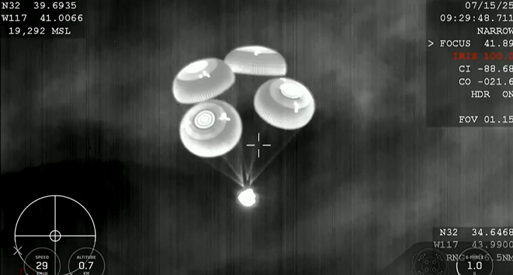
Dragon Capsule : 700 m before splashdown
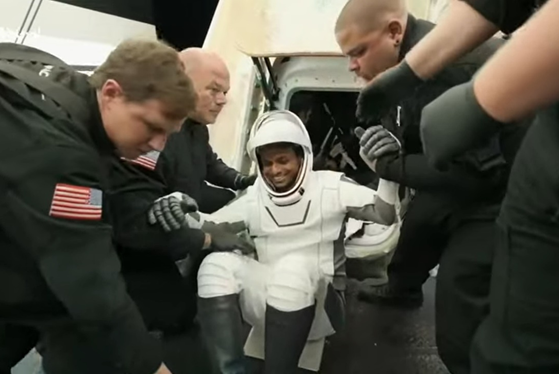
Gaganyatri Shubhanshu Shukla coming out from Dragon after successful mission
Post-Flight Status
Gaganyatri Shubhanshu Shukla is now undergoing a structured post-mission medical evaluation and recovery protocol under the supervision of Axiom Space and ISRO flight surgeons. This program, spanning seven days, includes cardiovascular assessments, musculoskeletal tests, and psychological debriefs aimed at ensuring full physiological recovery and data capture for future missions.
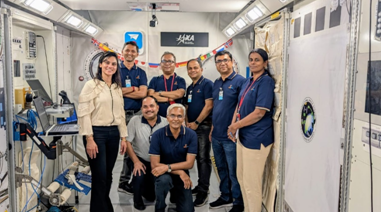
ISRO Mission Operation team at Johnson Space Centre, Houston
Mission operation exposure
As part of India’s participation in Axiom-04, a dedicated ISRO high-level delegation and Mission Operations Team was deployed to Kennedy Space Centre, Florida, which was led by the Chairman, ISRO and the Secretary, Department of Space, Dr. V Narayanan. The delegation participated in the launch operations. Initially, the launch was rescheduled multiple times due to technical issues including oxygen leakage in booster stage engine bay. On insistence of ISRO team, oxygen leakage issue was fully resolved leading to safe &successful launch. Later, the delegation moved to the Johnsson Space Centre, Houston, to join in the docking operations.
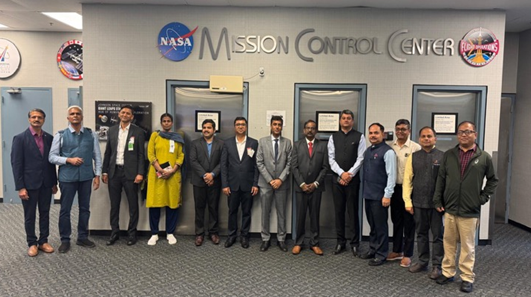
ISRO delegation with Secretary, Dept. of Space, Dr V. Narayanan at Johnson Space Centre, Houston
The Mission operations team continued to stay in Houston, gaining invaluable first-hand experience in managing human spaceflight operations. The team was embedded alongside NASA and Axiom flight controllers, participating in real-time decision-making, telemetry tracking, crew timeline management, and health monitoring of both the astronaut and the science payloads. This exposure provided critical insights into international crewed mission coordination, emergency response protocols, and the complexities of orbital operations.
This collaborative mission will serve as a vital stepping stone in building India’s own crewed mission operations infrastructure, enhancing readiness for future indigenous human spaceflight programs such as Gaganyaan and the Bhartiya Antariksha Station.
Quelle: ISRO
+++
Ax-4 Crew Splashes Down Completing First Mission to the International Space Station for India, Poland, and Hungary
After undocking from the International Space Station on Monday, July 14 at 6:15 a.m. CT, the Axiom Mission 4 (Ax-4) crew safely splashed down off the coast of California aboard SpaceX Dragon “Grace” on Tuesday, July 15 at 4:31 a.m. CT.
The Ax-4 crewmembers, led by Commander Peggy Whitson of the U.S., includes Pilot Shubhanshu Shukla of India, Mission Specialist Sławosz Uznański-Wiśniewski of Poland, and Mission Specialist Tibor Kapu of Hungary. For each of these countries, this mission has realized the return to human spaceflight, with all three nations sending astronauts to space for the first time in more than 40 years. Additionally, this marks the first time astronauts from India, Poland, and Hungary have conducted a mission on board the International Space Station.
“The Ax-4 mission is a powerful demonstration of what’s possible through commercial space,” said Tejpaul Bhatia, CEO of Axiom Space. “By enabling astronauts from India, Poland, and Hungary to carry out scientific research aboard the space station, we are supporting these nations in their contributions to human spaceflight. This mission reflects Axiom Space’s vision of a thriving low-Earth orbit economy, where access to space is no longer limited to a few, but extends to all who seek to explore, discover, and innovate.”
Over the course of their 18-day mission aboard the orbiting laboratory, the Ax-4 crew conducted more than 60 scientific experiments across a wide range of disciplines, including life sciences, materials research, Earth observation, and technology demonstrations. These investigations represented the interests of 31 countries, underscoring the mission’s global impact in advancing science and innovation in microgravity.
In addition to the scientific research, the crew participated in over 20 outreach events, connecting with a diverse global audience that included government officials, students, researchers, the media, and aspiring astronauts. These engagements served as a platform to share the mission’s goals, inspire future generations, and highlight the importance of international collaboration.
Ax-4 is the fourth in Axiom Space’s series of human spaceflight missions to the International Space Station. As the only private company to have successfully executed private astronaut missions to the orbiting laboratory, Axiom Space has expanded access to low-Earth orbit by enabling governments, academic institutions, private organizations, and individuals to engage in research, technology demonstrations, and educational outreach in space. In parallel, these missions serve as a precursor for Axiom Space’s long-term vision—the launch and operation of Axiom Station, the world’s first commercial space station.
Axiom Space’s previous missions have included astronauts from the United States, Spain, Israel, Canada, Saudi Arabia, Italy, Türkiye, and Sweden, with support from the European Space Agency (ESA). With Ax-4, Axiom Space continues to build a foundation for the future of commercial space, demonstrating the importance of international participation.
Quelle: AXIOM SPACE
